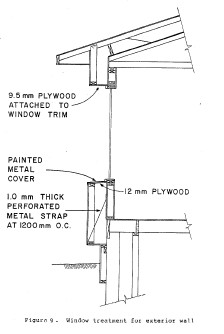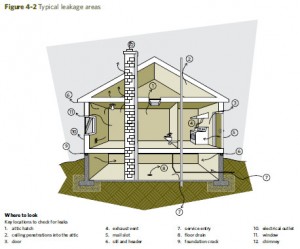Recently I had the privilege of interviewing Harold Orr, who was the project leader on the Saskatchewan Conservation House in the late 1970’s. He was involved in the invention of the residential HRV, and blower door tests, and his work influenced the Passive House and Net Zero movements. Now in his eighties, his brain contains a library of information on energy efficient building, and he talked to me for two hours straight. Orr’s main passion for the past several decades has been superinsulated retrofits of existing buildings, and he says the need for deep energy retrofits was obvious to him from early on.
The Saskatchewan Conservation House, now seen as a milestone in energy efficient building, was finished in 1977. “We recognized that as a first step,” Orr tells me, “the next step was to see if we can do this on a larger scale.” The province of Saskatchewan organized a competition, in which builders submitted proposals for a showcase of energy efficient homes – the challenge was to design and build homes that use only 25% of the heating of a conventional house. Orr was involved, along with Rob Dumont, in evaluating the proposals, “but we realized even as we did this that the number of houses that we build every year in a city is a small percentage of the houses that are already in a city.” Only in cities with a major building boom can you achieve a significant energy reduction, Orr explains, “so we were concerned about how we might do this on a conventional house.”
Orr and Dumont started looking for a house to retrofit and study the results, and by the end of 1981 they had found one in Saskatoon. This was the same year that the Superinsulated Retrofit Book, by Marshall and Argue, was published, describing double wall retrofits. The house Orr and Dumont had found was a 1968 bungalow with 2×4 stud walls and 2.95 air changes per hour (slightly better than the average house of that era).
 “We decided to do a major energy retrofit on the house, and we wanted to bring it up very close to the level of the Saskatchewan Conservation House,” Orr says. The whole process of this renovation is described in a report that Orr wrote with Robert Dumont. They performed blower door tests at each stage of the renovation to see how air-tightness of the house was affected. They took off the stucco and wrapped the walls with polyethylene, which was sealed down to the foundation and up to the top plate of the house, and not surprisingly the house was considerably more air-tight. Next they hung a second 2×4 wall off the exterior of the house, with an eight inch gap between the old and new wall. By the time they had insulated the cavity and the new wall, the combined insulation (including the existing insulation in the old wall) was about R50.
“We decided to do a major energy retrofit on the house, and we wanted to bring it up very close to the level of the Saskatchewan Conservation House,” Orr says. The whole process of this renovation is described in a report that Orr wrote with Robert Dumont. They performed blower door tests at each stage of the renovation to see how air-tightness of the house was affected. They took off the stucco and wrapped the walls with polyethylene, which was sealed down to the foundation and up to the top plate of the house, and not surprisingly the house was considerably more air-tight. Next they hung a second 2×4 wall off the exterior of the house, with an eight inch gap between the old and new wall. By the time they had insulated the cavity and the new wall, the combined insulation (including the existing insulation in the old wall) was about R50.
“That did the walls quite well, but we wondered what on earth to do about the roof,” Orr says. “Because one of the major problems in housing is the leakage between the house and the attic space.” Because of wood shrinkage there is nearly always a gap where the drywall meets the top plate, which Orr estimates is commonly 1/16 of an inch. Drywall is also not normally air tight at the floorline – so in most older houses air can travel behind the drywall, from the living space into the attic.
“So we thought why don’t we cut the tail end of the rafters off so it’s nice and smooth at the edge of the wall,” Orr recounts, “and we’ll put a piece of plywood over the raw edges that we’ve cut off, and then we can carry the vapour barrier that we’ve already put on the outside of the wall right over the roof and down the other side.” This is what is now known as the chainsaw retrofit – a time lapse of a later chainsaw retrofit was filmed by Orr’s son Robert.
“So anyway we’ve got the vapour barrier on the roof and we’ve got it tight,” says Orr. “Now we put 2×8’s, one at the edge of the roof, one at the peak of the roof and one half way in between. On top of this we put new rafters down the roof. In the 2×8 we put R28 and in the 2×4 rafters we put R12 which gives us R40 on the roof. Plus the insulation we already had in the attic which is likely around R20. Now the we’ve got R60 in the roof. We’ve got the outside walls of the house and the roof done, and we’ve got the house very very tight.” In fact Orr says that the 1981 retrofit was almost identical in its performance to the Saskatchewan Conservation House.
Orr has worked on a number of retrofits since, most recently a four-suite apartment in Regina. This renovation of basement, walls and roof had a cost of about 11$ per square foot for materials (including metal roofing), and about the same again for labour. Because the retrofit turned it from an undesirable to a desirable place to live, with commensurate increase in rent that could be charged, it has an eight year payback time – making it a phenomenal investment.
So the economics of the double wall, or superinsulated, retrofit are not bleak, though it’s a large investment, and finding the right contractor to do it is going to be important. But how does it compare to just tacking some foam to the outside of the house and re-siding it? According to Orr there is no comparison.
“I took four walls and assessed them,” Orr says. “One I put 2 inches of styrofoam on, at R5 per inch that would be R10. When you put 2 inches on you really have to strap it, because you cannot put siding on over 2 inches of styrofoam. And unfortunately 1×3 strapping is the same price as 2×4’s. So if you’re putting strapping on, why not use 2×4’s?” And why not center them away from the wall, for a double wall retrofit? Since foam insulation is so much more expensive than batt insulation, says Orr, “I can put in R60 for the same price as R10. Now you’ve got to persuade me that R10 is better than R60.” That’s just materials, labour will change that somewhat, but the point is made.
Orr has more to say, however, adding that “when you put styrofoam on the outside of a house you’re not making the house any tighter, all you’re doing is reducing the heat loss through the walls. If you take a look at a pie chart in terms of where the heat goes in a house, you’ll find that roughly 10% of your heat loss goes through the outside walls.” About 30 to 40 % of your total heat loss is due to air leakage, another 10% for the ceiling, 10% for the windows and doors, and about 30% for the basement. “You have to tackle the big hunks,” says Orr, “and the big hunks are air leakage and uninsulated basement.”

“I think the problem is that people don’t properly analyze where the heat is going. Get the book called keeping the heat in, it’s a publication of Natural Resources Canada [available as a free download], and anybody doing any work of this type should get this book and study it. If you look at where the heat goes the big chunk is air leakage, and usually putting styrofoam on the outside isn’t going to affect anything.”
I close the interview by asking why, so many years after retirement, he’s still doing this kind of work.
“It’s a passion with me,” he says. “I enjoy it. And I’m enough of a scotsman that it bothers me to see people wasting their money. I go by houses every day and I see them putting on an inch and a half of styrofoam, and lord help me – why don’t you do something for the same price and do it better?”
More information
History of the Chainsaw Retrofit

We were priviledged to have Harold’s help in our partial retrofit. We did things a little different – rigid insulation on the outside of the foundation – and we didn’t do our roof, but having his help and insight and advice was invaluable. Our natural gas bill is about half of what it was.